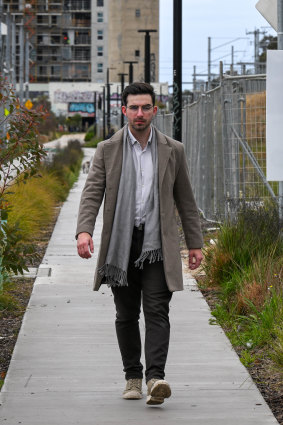
By 2051, Melton will be asked to add an extra 132,000 new homes, an increase of 190 per cent. Mitchell Shire, which takes in Beveridge and Wallan, is expected to increase dwellings from 21,800 to 89,800 by 2051 – up more than 300 per cent on the current housing stock. And Melbourne City Council’s suburbs will be expected to take 122 per cent more housing.
RMIT urban planning professor Andrew Butt welcomed the housing targets, saying they provided clarity and expectations.
But he encouraged the government to consider infrastructure targets, similar to those announced in Queensland, given the pressure that suburbs in Melbourne’s outer fringe and inner city were already under to accommodate hundreds of thousands of new dwellings.
“The load remains on the outer fringe and inner city, which have done their share,” Butt said.

Jonathan O’Brien, of YIMBY Melbourne, at Moreland station, where the group is proposing redevelopment.Credit: Eddie Jim
“If it’s all just about housing, then it’s missing out on other strategies such as community buildings, green space, social infrastructure. Where are the jobs targets? Where are the infrastructure targets?”
Jonathan O’Brien, from pro-development group YIMBY (Yes In My Backyard) Melbourne, said he was encouraged to see targets for municipalities where Victorians wanted to live, such as Darebin, Kingston and Yarra. These councils have been asked to boost dwelling numbers by between 85 and 103 per cent.
But he said the state government was still relying on fringe suburbs to drive the bulk of new homes and letting some middle-ring councils “off the hook”.
O’Brien said some municipalities such as Boroondara, asked to accommodate 67,000 new homes by 2051 to grow by 90 per cent, had been “let off” compared with other council areas. “The government is still taking a bit of a path of least resistance by allowing growth areas to take the majority of new homes,” he said.
New homes needed to be built “in places where Victorians want to live”. He pointed to Brimbank (which is to accommodate 72,000 new homes, or a 98 per cent jump in dwellings) and Maribyrnong (it will need to add 49,000 homes, or a 114 per cent increase in housing stock) as examples of municipalities that would struggle to reach their targets. “In some of those areas, the demand simply isn’t there,” he said.
Victoria’s branch of the Urban Development Institute of Australia argued that local councils would need support from the state government to address the housing crisis
“Some of the largest local government targets for delivering more houses are in the outer areas of Melbourne,” said its chief executive officer, Linda Allison.
She called on the government to approve more lots for housing development, saying independent modelling by the institute showed Victoria was “well behind in approving new land supply”.
Opposition planning spokesman James Newbury described the targets as “fake” and said they would not be reached.
Loading
“What I suspect the government is going to do is ... announce a big heavy penalty regime for any council that doesn’t meet these targets,” he said.
On Sunday, Allan wouldn’t be drawn on penalties for councils that failed to meet the targets, but accused some of not supporting the construction of new homes.
The Morning Edition newsletter is our guide to the day’s most important and interesting stories, analysis and insights. Sign up here.



























